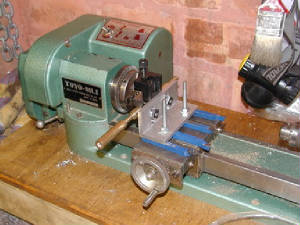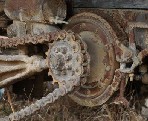|
But the fact is that just because I have not been doing anything does not mean
that nothing has been happening. Behind the scenes the engine is being slowly
stripped (more will follow on that in due course) and one small but vital component is receiving some attention courtesy of
my son, Dan.
Now Dan is an engineer by trade, and so he was a natural choice when I started
to strip the carburettor and found it to be in need of a little tender loving care.
The carb itself is a Stromberg
OT3 – a fairly standard looking updraft. Its mounting point, very low on
the truck chassis was a bit of a concern as it was clear that it had been badly affected by the weather, with lots of rust
on the linkage and, as far as I could see, the spindles. The main body though is either brass or bronze, so the likelihood was that it was salvageable. .

The throttle spindle goes into the lathe
So it proved, with the choke and float mechanism in good shape and the jets
reasonably clear. The Big Issue though was the throttle butterfly, and its associated
spindle which was locked solid.
No amount of persuasion, either by stealth (immersion in a tub of release agent
for a month), trickery (various applications of heat and cold) or brute force (levers and hammers) did the trick, and, eventually
the inevitable happened and the (by now fatigued) spindle on the outside of the carb gave way..
This did allow me however to take a radical approach, which was essentially
to remove the butterfly with a circular cutter then look more closely at where the problem was.
What I discovered was a brass spindle (explaining how easily it had broken
once beaten half to death with a decent hammer) set into steel bushes pressed into a bronze carb body. Now with the greatest respect to the early truck building pioneers in general and Messrs Stromberg in particular
that combination is only almost right. Had the components and materials been
the other way around (as, indeed, were the ones for the choke butterfly) then things might have been different. As it was I had an anxious hour or two gently but firmly drilling then pressing out the bushes ands remnants
of the spindle from the carb body without damaging the latter.
Suffice to say that every trick known to man was employed during that particular
evolution but the end result was a pile of scrap bits on the bench but a carb body that was perfectly intact. And then the whole problem was handed over to Dan. The pictures
show his work on both the new spindle and the tricky exercise of cutting a slot into it for the throttle butterfly itself. The latter is an interesting challenge in that the original was quite thick and when
fully closed sat at an angle in the throttle body rather than directly across it at 90 degrees. The reason for that would be so that it could not jam if the combination of throttle closure spring and
the significant vacuum on closing the throttle on, say, the over-run banging the butterfly shut. I have seen other solutions to the same problem solved with small spring-loaded pressure relief valves
in the butterfly itself to a butterfly mounted off-centre on the spindle in such a way that the vacuum wants to open the butterfly
not close it (but overcome in any event by the spring)
But the Stromberg solution mean that the new butterfly had to be made in what
was an ellipse rather than a circular disc. To do that Dan cut an oversized disc,
then mounted it into an arbor made of two halves cut at an angle. Thus the disc
“wobbles” in the arbor, and then running it gently through the lathe not only forms the ellipse, but also ensures
that the outer edges of the butterfly are formed parallel to the inner surface of the throttle.
So, a lot of work for a small component.
But without it the mighty Mack would stand no chance whatsoever of running again.
Small? - yes, vital? – you bet.
|

